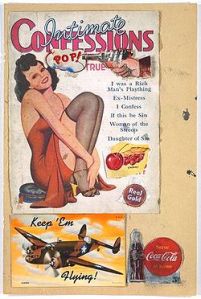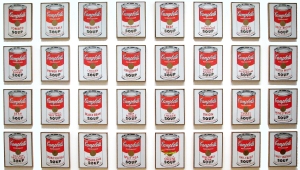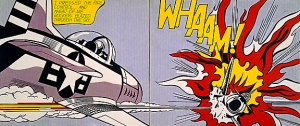The real beginning of pop art was the coining of the term by one of the biggest creators of pop art, Paolozzi, in England 1947. It took huge inspiration from cubist and dada collage work, futurism imagery and even what could be considered the surrealist dogma (by which the art was about ordinary objects and ordinary objects are sometimes ignored- subconsciously picked up) All this was happening in and around the time that abstract expressionism was taking place in America, and that is were Pop art really came into its own, with artists like Andy Warhol, Lichtenstein, Jasper Johns and Robert Rauschenberg. They were also teamed with a famous musician and choreographer, the couple Merce Cunningham and John Cage who aided the development and together they came across the mid point between art and everyday life-Pop Art. Other famous artists of the period include Claes Oldenburg, James Rosenquist, Tom Wesselmann and Robert Indiana.
and choreographer, the couple Merce Cunningham and John Cage who aided the development and together they came across the mid point between art and everyday life-Pop Art. Other famous artists of the period include Claes Oldenburg, James Rosenquist, Tom Wesselmann and Robert Indiana.
Richard Hamilton was vital in the setting up of the movement, his piece “What is it today that makes homes so different, so appealing?” It drew on the collage works of the dada movement and also incorporated elements of the time. This contemporariness is what made the work so interesting. Artists before had painted of their time and been ridiculed, such as Manet, with his “Bar at the Folies Bergere” who was ridiculed for depicting the growth in Paris at the time. This collage brings together elements of the time such as pin ups, the design of the time and even has the word POP written on it.
A later group of artists including Segal and Samaras were also to play a vital role in the unfolding of Pop art.
 Paolozzi the first real member and inventor of the term pop art came from Britain where around the time, the country was recovering from its state of war. This meant to a huge rise in foods and generally a rise in spirits. The market became a consumerist one again, which lead him to have a statement to his art. His piece “I was a rich man’s plaything” sparked controversy in 1952 where it shows a scantily dressed pin up girl on a pin board like setting. This setup was a very new thing and lead to the generation of art as a representation of what society had become. In a way, it could have been seen as a satirical reference, implying that we had forgotten the times of the war, and moved on too quickly when so many people had been affected by the death and suffering. In other ways it could be seen as a way to cheer people up after a time of great sadness.
Paolozzi the first real member and inventor of the term pop art came from Britain where around the time, the country was recovering from its state of war. This meant to a huge rise in foods and generally a rise in spirits. The market became a consumerist one again, which lead him to have a statement to his art. His piece “I was a rich man’s plaything” sparked controversy in 1952 where it shows a scantily dressed pin up girl on a pin board like setting. This setup was a very new thing and lead to the generation of art as a representation of what society had become. In a way, it could have been seen as a satirical reference, implying that we had forgotten the times of the war, and moved on too quickly when so many people had been affected by the death and suffering. In other ways it could be seen as a way to cheer people up after a time of great sadness.
Warhol is probably the best known of the artists becoming a household name and superstar  in a nation gripped with the consumerist idea. He organised a factory(abley named as he himself produced work like a factory, making more and more copies of the pieces with use of printing methods) were creative people came together from all sorts of backgrounds, art, music, design, dance and they collaborated. This kind of grouping wasn’t a completely new idea, artists such as Picasso had experimented with the idea before and it certainly proved it worked. In the nineties, the BritArt movement or YBAs had a similar concept involving musicians such as the BritPop bands, Blur mainly, and others, the whole lifestyle became a great idea with everyone benefitting. In Warhol’s silkscreen printing of Campbell’s soup cans, he turns the banal object into art. Also what is important in this piece is the comment on the society he was living in, the variety and choice of different flavours represents the choice that the population had in its consumerist market.
in a nation gripped with the consumerist idea. He organised a factory(abley named as he himself produced work like a factory, making more and more copies of the pieces with use of printing methods) were creative people came together from all sorts of backgrounds, art, music, design, dance and they collaborated. This kind of grouping wasn’t a completely new idea, artists such as Picasso had experimented with the idea before and it certainly proved it worked. In the nineties, the BritArt movement or YBAs had a similar concept involving musicians such as the BritPop bands, Blur mainly, and others, the whole lifestyle became a great idea with everyone benefitting. In Warhol’s silkscreen printing of Campbell’s soup cans, he turns the banal object into art. Also what is important in this piece is the comment on the society he was living in, the variety and choice of different flavours represents the choice that the population had in its consumerist market.
 Lichtenstein also made a comment on society with his brash blown up paintings of comic strips. He used ben-day dots in his works which describe emotional scenes, sometimes with a relationship, other times with war references. This was relevant as it was around at the same time as the Vietnam War. In his painting “Whaam” Lichtenstein plays with the viewers feelings, presenting quite a serious situation in a comic strip form, thus making it seem less disastrous. This is similar to some of Warhol’s prints were he depicts scenes such as car crashes but with hugely bright colours underneath the ink to juxtapose the two elements. This can also be seen in works during the BritArt movement such as the hugely controversial Myra Hindley portrait by Marcus Harvey, which was painted by childrens handprints.
Lichtenstein also made a comment on society with his brash blown up paintings of comic strips. He used ben-day dots in his works which describe emotional scenes, sometimes with a relationship, other times with war references. This was relevant as it was around at the same time as the Vietnam War. In his painting “Whaam” Lichtenstein plays with the viewers feelings, presenting quite a serious situation in a comic strip form, thus making it seem less disastrous. This is similar to some of Warhol’s prints were he depicts scenes such as car crashes but with hugely bright colours underneath the ink to juxtapose the two elements. This can also be seen in works during the BritArt movement such as the hugely controversial Myra Hindley portrait by Marcus Harvey, which was painted by childrens handprints.
The Pop art era was certainly a spectacular one with controversial pieces of work and clever imagery. It moved on into the fluxus movement involving performance, installations, film works and collage which broadened the topic out so much it diluted the Pop Art idea. However, the idea can still be seen in works later on involving everyday life and its surroundings. A good example would be Sarah Lucas’ sculptures, with kebabs, fried eggs and cigarettes featuring in some of her work.